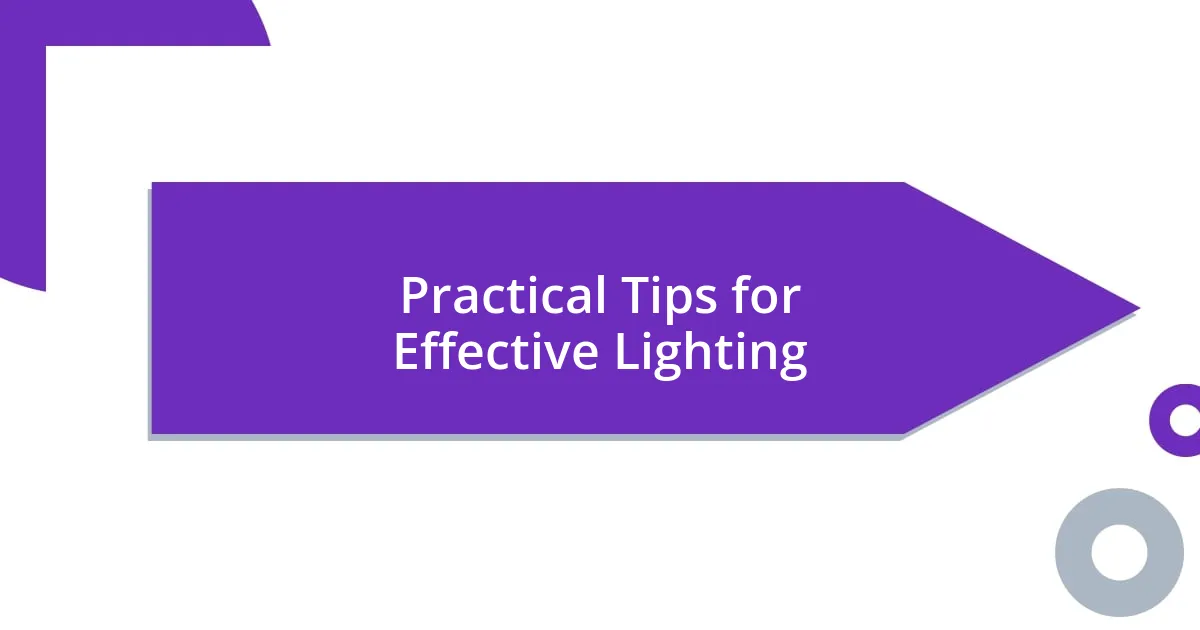Key takeaways:
- Light significantly affects mood and productivity; adjusting lighting can transform how we feel and work.
- Different types of natural light (direct, diffused, reflected) each have unique qualities that enhance our environments and experiences.
- Layered lighting techniques, including the use of various sources at different heights, can create inviting and dynamic atmospheres in spaces.
- Color temperature influences emotional states; warmer tones foster comfort while cooler tones promote focus and energy.

Understanding the Importance of Light
Light isn’t just a utility; it plays a critical role in shaping our moods and daily experiences. I still remember a rainy day when the clouds cast a gloomy shadow over my workspace. Despite my initial inclination to curl up and be unproductive, I decided to turn on a warm lamp. Suddenly, the atmosphere shifted, and I felt more energized and ready to tackle my tasks. Isn’t it fascinating how a simple adjustment of light can elevate our spirits?
Furthermore, the way we utilize natural light can significantly influence our productivity. I’ve found that some of my most creative ideas emerge when I position my desk to catch the morning sun. The brightness floods my space and instantly sparks inspiration. How often do you notice the effect of sunlight on your work or home environment? That kind of awareness can be a game changer for anyone looking to enhance their daily output.
On a deeper level, the importance of light touches on our well-being. In moments of stress, I’ve learned to adjust my surroundings by switching to softer, cooler lighting, creating a more calming atmosphere. This simple act transforms my mindset and helps me feel more at ease. Have you ever experienced a similar shift? It’s truly remarkable how light influences our internal states, isn’t it?

Types of Natural Light Sources
Natural light sources come in various forms, each with unique characteristics and impacts. I’ve often noticed that direct sunlight, especially during the golden hour, creates a warm, inviting glow that enhances the aesthetic of my living space. This type of light is not only beautiful but invigorates my mood, making everyday activities feel special.
On the other hand, diffused light, like that seen on overcast days, offers a softer quality that’s perfect for creating a serene environment. I recall a particular afternoon when I decided to read by the window as the clouds filtered the sunlight. It felt calming and almost meditative, helping me unwind while still staying productive. It’s incredible how different light conditions can alter our experiences, wouldn’t you agree?
Lastly, reflected light can add depth and dimension to a room. When I strategically place mirrors to catch the sunlight streaming in, it brightens up darker corners and creates a sense of space. This technique not only enhances my home’s interior but also gives me that little boost of energy I need when I’m feeling sluggish. Understanding how to manipulate light can truly transform our spaces and moods.
| Type of Natural Light | Characteristics |
|---|---|
| Direct Sunlight | Bright, warm, energy-boosting; great for mood enhancement. |
| Diffused Light | Soft, even illumination; perfect for relaxation and focus. |
| Reflected Light | Creates depth and brightness; ideal for enhancing darker areas. |

Choosing the Right Lighting Direction
When it comes to lighting direction, I’ve discovered that the angle of light can completely redefine a space. For example, when I place my desk so that the light comes from the side, it creates a soft shadow that adds depth to my workspace. This not only makes me feel more connected to my environment but also enhances my focus. I often think about how side lighting brings out textures in my work, from the pages of a book to the details in my sketches.
- Front Lighting: Illuminates evenly, great for tasks requiring attention to detail.
- Side Lighting: Creates dimension and enhances focus; perfect for artistic endeavors.
- Back Lighting: Adds drama but can obscure details; often used for creating silhouettes.
I’ve also noticed how overhead lighting impacts my mood. There have been days when the harsh overhead fluorescent bulbs made me feel off-kilter. By switching to a lamp that casts a warm glow from above, I’ve felt the tension release. This small change transformed my work environment into a space of comfort, allowing my creativity to flow more freely. Have you ever noticed how these subtleties can affect your day? It’s amazing how the right lighting direction can set the tone for our productivity and well-being.

Enhancing Space with Artificial Light
There’s something magical about how artificial light can completely transform a room. I remember moving into my new apartment and feeling overwhelmed by the stark, white overhead lights. It felt so cold and uninviting. After experimenting with warm LED bulbs and soft lamps, the atmosphere changed overnight. The glow created a cozy space that felt more like home. Isn’t it interesting how something as simple as a light bulb can evoke such a strong emotion?
Embracing layered lighting has been a game-changer for enhancing my space. I began by adding multiple light sources at different heights, like floor lamps and table lamps, to create a more dynamic feel. This approach not only brightened up the room but also allowed me to control the mood depending on the time of day. On quiet evenings, I love dimming the lights and curling up with a book, surrounded by a soft, golden glow. Have you ever noticed how the right lighting can make a mundane evening feel special?
One of my favorite tricks is using color-changing LED lights to set the scene for different activities. For instance, when I’m entertaining friends, I often switch to vibrant colors that energize the atmosphere. However, when it’s time to unwind after a long day, I dial it back to soothing blues or gentle purples. It’s fascinating how these subtle changes in light can influence our emotions and even our interactions. What color do you think would brighten your day?

Using Color Temperature for Mood
When it comes to mood, color temperature plays a pivotal role in shaping how I feel in my space. For example, I tend to gravitate toward warmer tones—think amber or soft yellows—when I want to create a sense of comfort and coziness. On chilly evenings, I’ll often set my lights to a warm hue to mimic the feel of a log fire, and it instantly wraps me in a blanket of relaxation. Have you ever tried adjusting your lighting color as a way to shift your emotional state?
I also find that cooler color temperatures—like those crisp whites and soft blues—are invigorating when I need to tackle a project or focus on deep work. For instance, in the morning when the sun is just rising, I aim for bright, cool lights to help wake me up and encourage productivity. There’s something about that fresh light that feels like an invitation to seize the day. Do you ever feel more energized with certain lighting?
Lastly, during creative endeavors, I often swap to specific color temperatures to tap into different emotions. When I’m sketching or brainstorming, balancing between warmer and cooler tones allows me to navigate between comfort and analytical clarity. Recently, while working on a new art project, I lit my space with a bright daylight color to inspire precision, and it made all the difference. How do you harness light to elevate your creative process?

Creating Layered Lighting Effects
Creating layered lighting effects can really enhance the way a space feels. I remember one evening when I decided to experiment with this concept—using a combination of wall sconces, a striking pendant light, and a few well-placed candles. The interplay of light and shadow made my living room feel so much larger and more inviting. How often do you think about using different sources of light to reshape a room’s atmosphere?
I usually recommend starting with a focal point, like a beautiful lamp or striking overhead fixture, and then building around it. For a recent dinner party, I layered my lighting by including a chandelier set to warm tones complemented by candles on the dining table. The combination created that perfect intimate vibe, sparking laughter and conversations long into the night. Has there been a moment when you felt the power of layered lighting in your own gatherings?
One of the easiest ways I’ve found to achieve this layered effect is by utilizing task lighting. Whether it’s a bright desk lamp for focused work or a soft light in a reading nook, these different layers serve distinct purposes. During a late-night work session where I was battling a looming deadline, the bright task light helped keep my energy up, while the gentle glow of a nearby floor lamp kept the space cozy. Isn’t it incredible how the right mix can boost productivity while ensuring comfort?

Practical Tips for Effective Lighting
When it comes to maximizing lighting effectiveness, I find that adjusting natural light is a game changer. I always open my curtains wide during the day to let sunlight pour in—this not only energizes my workspace but also enhances my mood significantly. Have you noticed how a sunny day has the power to uplift your spirits? It’s a simple yet impactful adjustment that can truly transform the atmosphere of a room.
In the evenings, I often switch to dimmable fixtures to control the intensity of the light. There’s something serene about soft, adjustable lighting that creates an inviting ambiance, especially during those quiet times when I curl up with a book. Just the other night, I dimmed my living room lights while listening to music, and it felt like the entire space enveloped me in warmth and calm. How do you set the mood in your home as the day draws to a close?
One practical tip I always share is to experiment with colored light bulbs. Recently, I swapped out a few traditional bulbs for vibrant hues in my home office, and it sparked joy and creativity in my work routine. I specifically chose an energetic teal for inspiration, and it has completely transformed my vibe. Have you ever tried incorporating color into your lighting scheme? The right shade can make a world of difference in how you approach your tasks.












